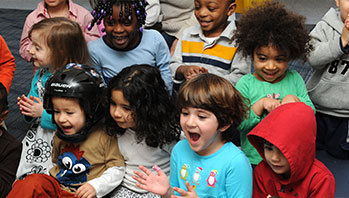- beans
- flowerpot or window box
- name cards
- sentence strips and chart
- sprout
MA Standards:
English Language Arts/Speaking and Listening/SL.PK.MA.1a: Observe and use appropriate ways of interacting in a group (e.g. taking turns in talking, listening to peers, waiting to speak until another person is finished talking, asking questions and waiting for an answer, gaining the floor in appropriate ways).
English Language Arts/Foundational Skills/RF.PK.MA.3.c: Recognize one’s own name and familiar common signs and labels (e.g., STOP).
Head Start Outcomes:
Social Emotional Development/Self-Regulation: Follows simple rules, routines, and directions.
Language Development/Receptive Language: Attends to language during conversations, songs, stories, or other learning experiences.
Literacy Knowledge/Print Concepts and Conventions: Recognizes print in everyday life, such as numbers, letters, one’s name, words, and familiar logos and signs.
PreK Learning Guidelines:
English Language Arts/Language 1: Observe and use appropriate ways of interacting in a group (taking turns in talking; listening to peers; waiting until someone is finished; asking questions and waiting for an answer; gaining the floor in appropriate ways).
English Language Arts/Reading and Literature 12: Listen to, recite, sing, and dramatize a variety of age-appropriate literature.
Greeting Song: “Where Is?” #13

© Commonwealth of Massachusetts, Department of Early Education and Care (Jennifer Waddell photographer). All rights reserved.
ELA Focus Skills: Name Recognition, Follow Directions, Phonological Awareness (Rhythm and Repetition)
Educator Prep: Fill the flowerpot or window box with beans and half-bury the name cards in the beans.
Sing the song once before you begin. Hold up the window box filled with name cards. Tell children you are going to pick a name card out of the box (just like you pick flowers out of a garden) and place it in the chart before you sing to each child. Say, When you see your name being placed into the chart, I want you to stand up slowly—sprouting like a seed—and get ready to sing with me. Demonstrate with one child who easily recognizes his or her written name.
- Place the name card in the chart. The child should stand up. (If the child does not recognize his or her written name, signal to the child and draw attention to the letters in the name. For example, say, Come, Nicholas. This is your name. Notice the “N” for /n/ in N-N-N-Nicholas. Sweep your finger under the “N” as you say the name.)
- Sing the first line and tell the child to respond by singing, “Here I am! Here I am!
- Sing the third line and tell the child to respond by singing, “Very well, thank you! Very well, thank you!”
- Then sing the last line and have the child sit down.
Where Is?
(sung to the tune of “Where is Thumbkin?”)
(Educator:)
Where is <name of child>? (Hold up child’s name card)
Where is <name of child>?
(Child stands up and sings:)
Here I am!
Here I am!
(Educator:)
How are you today, <name of child>?
How are you today, <name of child>?
(Child:)
Very well, thank you!
Very well, thank you!
(Educator:)
Please sit down.
Please sit down.
Take It Further: It can be a challenging concept for children to grasp that plants are living things with characteristics in common with other living things because plants don’t make noise, walk, etc. Help children grasp this concept by asking questions such as, How were you being like a plant when we were singing? Emphasize that plants, like animals, grow if their needs are met. Ask, What do plants need to survive? What do you need to survive? Emphasize that plants have characteristics in common with other living things.
Adaptation: For groups with very young children or children who do not yet recognize their name in print, you might want to give children direct acknowledgement before you sing the song to them. For example, say, Get ready Tamara, we will be singing to you next. Watch for your name card. It will begin with a “T” for T-T-T-Tamara.
